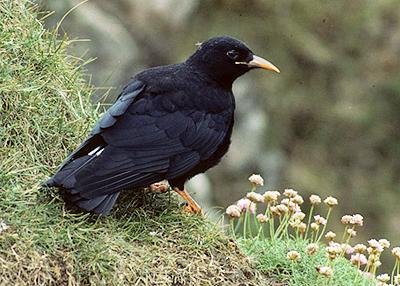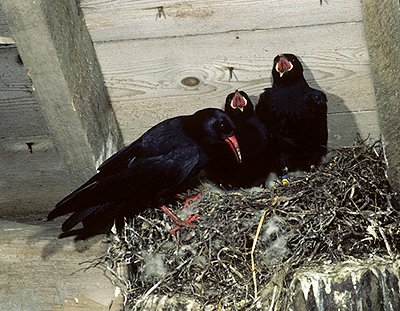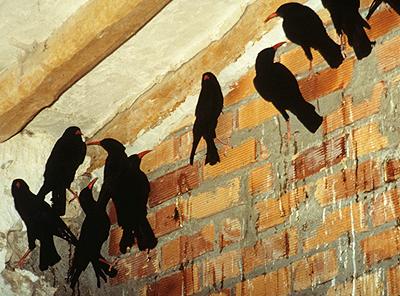HNV Farming & Species
Red-billed chough (Pyrrhocorax pyrrhocorax)

| Common name: | Red-billed chough (EN), Alpenkrähe (DE) |
|---|---|
| Scientific name: | Pyrrhocorax pyrrhocorax |
| Conservation status: | Annex I, Bird directive |
| Red data book (IUCN): | LC (least concern) |
| Population trend: | moderate decline (globally); large decline in Europe between 1970-1990; European population estimated at 86.000-210.000 ind. (IUCN 2007); still declining in key countries Spain & Turkey |
Distribution

The global range of the Chough extends from the European Atlantic coast in the west across mountainous areas of southern Europe and central Asia, to India and China. There are isolated population in the Ethiopean Highlands and in Morocco.
Although the overall species range is very large, the actual distribution of Chough is highly localised – especially in Europe. In Britain and Ireland, where it reaches its north-western distribution edge, it is essentially a coastal species, while in more central European countries (e.g. France, Switzerland, Austria, Italy, Greece) it occurs in mountainous landscapes. Only in Spain is the species more widespread.
Habitat requirements
Choughs nest in caves and recesses in cliffs or in suitable buildings. Breeding pairs defend a home range of varying size and remain there for most of the year, roosting at or close to the nest. Pre-breeders (sub-adults) form flocks that roost communally both on cliffs and in buildings.
Choughs feed predominantly on arthropods, principally soil-living, surface-active and dung-associated invertebrates. Their preferred foraging areas generally being grasslands of various types: particularly favoured are sand-dunes, sand grasslands and machair as well as agricultural grasslands including leys, old pastures and meadows, permanent grasslands, both acidic and calcareous, as well as a range of rough grazing areas, moorland grassland and dwarf-shrub heaths.
Ecology

Nest building begins in March and egg-laying starts in early April. The most frequent clutch size is five (smaller in first-time breeders). Between 1992 and 2004, breeding success (the number of young fledged from nests) in Islay varied from 1.29 to 2.62. The average was 1.76 for 1992-1997 and 2.29 for 1998-2004. Eggs hatch asynchronously after 21 days and the first young leave the nest after six weeks, but the fledglings generally stay in the cave or building for another week before joining the parents on the home range. Within three or four weeks the parents escort the young to the communal roost.
It is at this time of the year (late July-early August) that the highest numbers are recorded at the roost, although breeding pairs soon return to their home ranges and leave fledglings to fend for themselves. Most pairs mate for life and several birds are still breeding in their teens, although breeding success declines with age after about ten years. The oldest known birds are paired, a 20 year-old male and a 23 year-old female.
Importance of HNV Farmland
The Chough's bill is specialised for digging and probing for invertebrates, and habitat preferences reflect this. It requires a range of habitats where invertebrates can thrive and are available year round. In Scotland these places are associated with relatively low-intensity pastoral livestock farming in areas of high natural diversity, mostly near the coast. The resulting vegetation and land-use mosaics produce a wide variety of feeding opportunities and prey items.
Some of these are natural, such as rocky outcrops in pastures, sand dunes with larvae of the Mining Bee, ant-hills in old grasslands and fly larvae in rotting kelp on sandy shores. Others are anthropogenic, such as cereal stubble and long-rotation unfertilised pastures, as well as the “micro-habitats” and untidy features associated with the agricultural landscape. The latter include earth banks, field clearance cairns, old walls, middens and even livestock burial areas.
Such features have been lost in the more intensively farmed parts of Scotland. The importance of extensive livestock rearing is difficult to over-emphasise; it restricts vegetation growth and so provides the access to bare ground that foraging Choughs need. In certain situations, particularly on sand dunes and limestone grassland, cattle dung can provide a rich source of easily located invertebrate food. Cultivation of animal fodder, especially cereals and arable silage (and their aftermath) creates supplementary feeding opportunities during winter.
Changes in distribution and numbers in recent years are difficult to attribute to land management. However, the low-intensity, extensive pastoral farming and the abundance of natural and man-made nesting sites are crucial to Choughs. However, these do not explain why so much apparently suitable habitat is unoccupied, for example on Mull. Neither can it explain the recent increases in Colonsay. Nor can the expansion, contraction and then recovery in Islay be explained by land-use change, management-practices or nest site availability.
Back to Overview Species
